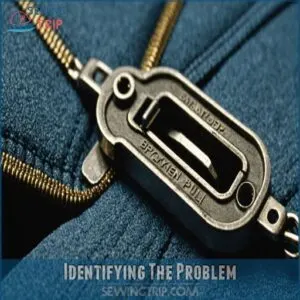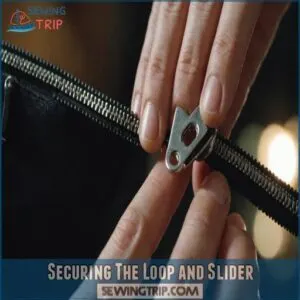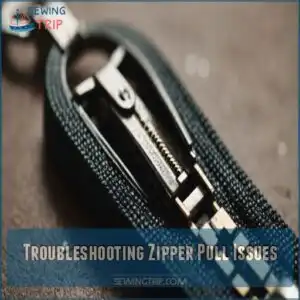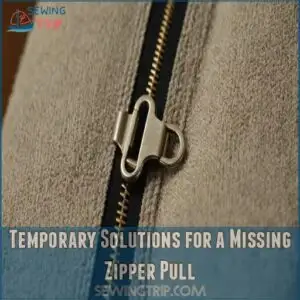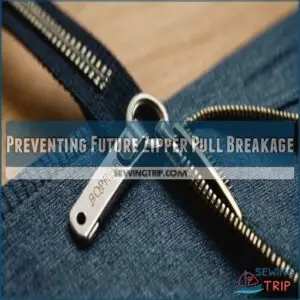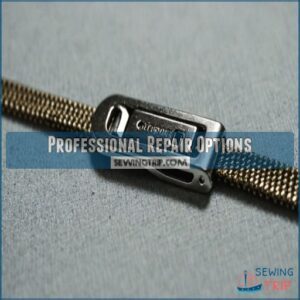This site is supported by our readers. We may earn a commission, at no cost to you, if you purchase through links.
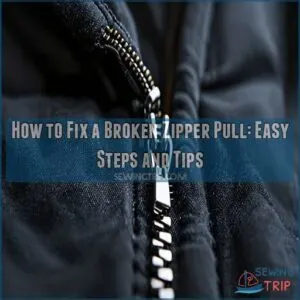 That broken zipper pull got you down? Don’t worry, fixing it is easier than you think!
That broken zipper pull got you down? Don’t worry, fixing it is easier than you think!
First, assess the damage. Is it just bent? Use pliers to gently reshape it.
Completely broken? A sturdy zip tie makes a great replacement. Just thread it through the slider.
A key ring works too, in a pinch.
Learning how to fix a broken zipper pull gives you a sense of accomplishment. And, you’ll save money!
There are more advanced techniques, of course… but this gets you back in business quickly.
Want to know how to prevent this from happening again? Read on!
Table Of Contents
- Key Takeaways
- Identifying The Problem
- Removing The Old Zipper Pull
- Choosing a Replacement Zipper Pull
- Installing The New Zipper Pull
- Troubleshooting Zipper Pull Issues
- Temporary Solutions for a Missing Zipper Pull
- Preventing Future Zipper Pull Breakage
- Replacing a Zipper Slider or Teeth
- Fixing a Separated or Stuck Zipper
- Professional Repair Options
- Frequently Asked Questions (FAQs)
- Conclusion
Key Takeaways
- Identify the problem with your zipper pull by assessing whether it’s bent, missing, or stuck, as this determines the right fix.
- Use simple tools like pliers to reshape a bent pull or a zip tie as a makeshift replacement for a broken one.
- Install a new zipper pull by ensuring it matches the original’s size and material, making sure it fits snugly on the slider.
- Prevent future issues by regularly checking zipper alignment and using lubricants like a graphite pencil to keep it functioning smoothly.
Identifying The Problem
Before fixing a broken zipper pull, you first need to identify the problem, like whether the pull is simply missing or stuck.
Knowing the type and material of your zipper pull can help you choose the right solution.
Broken Zipper Pull Symptoms
Imagine this: you’re zipping up your favorite jacket and suddenly, the zipper’s not cooperating.
Symptoms of a broken zipper pull can be frustratingly clear. The pull tab might be loose, or the slider won’t move smoothly. You might give it a gentle tug, but alas, the zipper won’t close.
Recognizing these signs early helps in planning your zipper fix.
Zipper Pull Types and Materials
Knowing your zipper pull’s material is key to fixing it.
Common types affect zipper pull durability, and understanding the different zipper types and materials can be helpful in this process, such as choosing between nylon zippers.
Consider these:
- Metal: Durable, but can snag.
- Plastic: Lightweight, but less durable.
- Fabric: Unique designs, but might fray.
- Vintage: Often charming, but may be fragile.
Choosing the right replacement makes for a smooth zip.
Metal vs. plastic is a big decision!
Think about custom zipper pull ideas for a personalized touch.
Removing The Old Zipper Pull
To remove the old zipper pull, you’ll need to determine if the loop is closed or open.
Use pliers or a screwdriver to carefully pry off closed loops, or simply wriggle the pull tab free from open hooks.
Prying Off Closed Loops
You’ve pinpointed the issue, now grab those pliers or metal snips to tackle closed loops.
Stubborn loops mightn’t cooperate, so steady your hand while removing the old zipper pull tab from its loop.
Before you start, make sure to check for damaged teeth, as misaligned or damaged ones can cause further problems down the line.
It’s a small task, but fixing a broken zipper gives triumph in simplicity.
Here’s a quick look at your trusty tools:
| Tool | Purpose | Emotion |
|---|---|---|
| Pliers | Grip and pry | Determination |
| Metal Snips | Cut stubborn loops | Confidence |
| Zipper Slider | Holds pull tab | Patience |
| Screwdriver | Open stubborn hooks | Steadiness |
| Zipper Pull | Replacement part | Achievement |
Handling Open Loops and Hooks
Struggling with open loops or those pesky hooks? Good news: removing an old zipper pull isn’t rocket science.
When tackling these, remember:
- Lift the pull tab: It’ll easily slide off if not secured.
- Wriggle it free: For hook-style loops, gently jiggle that sucker until it’s out.
- Need a tool?: A flat-head screwdriver works wonders if stuck.
This prep sets the stage for a clean zipper pull installation.
Choosing a Replacement Zipper Pull
When choosing a replacement zipper pull, make sure it matches the size and material of your original zipper.
You can find a variety of options both online and in stores, making it easy to pick the right one for your needs.
Selecting The Right Size and Material
When choosing a replacement zipper pull, consider the size comparison and material compatibility.
A large pull fits a big zipper slider, while a small pull suits a delicate zipper.
Match materials for zipper pull durability—metal for metal sliders, plastic for plastic sliders.
Make sure the pull tab design aligns with your zipper slider and teeth’s functionality to prevent issues.
Finding Replacement Zipper Pulls Online and In-Store
With size and material sorted, you’re ready to hunt for replacement zipper pulls.
Start by browsing online for zipper pull brands and do online retailer comparisons for the best deals.
Want a hands-on approach? Visit local stores. Here’s how:
- Check craft stores for DIY options.
- Try fabric shops for variety.
- Look into zipper repair kits.
Installing The New Zipper Pull
Now you’re ready to install your new zipper pull! Simply slip the new pull onto the slider, making sure it’s securely fastened, and you’re good to go.
Positioning The Replacement Pull Tab
You’ve picked the right zipper pull, now let’s put it on.
Align the replacement pull tab with your zipper slider to avoid any future headaches, and also make sure the zipper slider is properly secured and tight, which is important in common zipper problems.
Make sure it fits snugly to prevent slippage.
Here’s a quick comparison to help:
| Pull Tab Material | Fits Zipper Type |
|---|---|
| Metal | Heavy-duty jackets |
| Plastic | Backpacks, purses |
| Fabric | Casual wear |
| Rubber | Sports gear |
Securing The Loop and Slider
Positioning the replacement pull tab is only half the battle.
Now, make sure zipper pull stability by pressing down on the loop until it aligns with the slider.
For a more secure fix, you can use specialized tools found in zipper slider repair kits available online.
Apply steady slider pressure to keep everything intact.
Use a block or marker end to secure the loop and slider, preventing slippage.
Here’s how:
- Press firmly
- Double-check alignment
- Use consistent pressure
Troubleshooting Zipper Pull Issues
When fixing a zipper pull, you’ll need to handle locking mechanisms and broken tabs carefully to prevent further issues.
It’s important to make sure the zipper slider stays intact while making repairs, so work slowly and use the right tools.
Dealing With Locking Mechanisms and Broken Tabs
Got the new zipper pull installed? Great! Now, focus on identifying locking mechanisms that keep things snug.
If the tab’s broken or common zipper pull issues pop up, removing it carefully without harming the zipper slider is essential.
Replacing broken tabs with similar size helps prevent future headaches.
When your zipper is fully separated, the right fix saves the day!
Avoiding Damage to The Zipper Slider
To keep your zipper slider in tip-top shape, handle it with care.
Avoid force when pulling, and gently align your zipper pull to prevent slider damage.
For more delicate or stubborn issues, consider investing in a zipper pull fix kit from a reliable source like Zipper Pull Repair.
A bit of lubrication can work wonders for smooth operation.
Remember, a temporary fix might get you through the day, but regular zipper maintenance guarantees long-lasting wear.
Your slider will thank you!
Temporary Solutions for a Missing Zipper Pull
When you’ve lost your zipper pull, don’t worry, there are quick fixes you can try.
Grab a key ring, a piece of cord, or even a paper clip, and you’ll have your zipper working again in no time.
Using Key Rings and Cords as Alternatives
A simple key ring, perhaps one of the smaller key ring sizes, makes a great temporary zipper pull.
Just open the ring and slip it onto the zipper slider.
For a more durable solution, try a sturdy cord.
Thread it through the slider’s loop, then tie a secure knot.
These are quick, easy temporary fixes until you can find a proper replacement zipper pull tab.
These alternative materials offer immediate garment repair.
Creating a DIY Zipper Pull With Fabric and Ribbon
Your zipper pull broke? Let’s craft a DIY fix with fabric and ribbon! Choose sturdy fabric, add some ribbon for flair, and follow these steps: To get the job done, you might want to review the basics on how to sew a zipper. – Cut fabric and ribbon into strips.
- Loop through the zipper slider.
- Secure with a strong knot.
- Use sewing techniques to add durability.
- Decorate with embellishments for a personal touch.
Simple, practical, and stylish!
Preventing Future Zipper Pull Breakage
To keep your zipper pulls from breaking in the future, it’s important to maintain proper alignment and regular lubrication.
Avoid overusing or putting too much strain on zippers by gently guiding them and using lubricant like WD-40 to make sure they operate smoothly.
Maintaining Proper Zipper Alignment and Lubrication
After using a keyring to replace your missing zipper pull, focus on zipper alignment and lubrication.
Regularly check for misaligned teeth and smooth operation.
For instance, you can address misaligned zipper teeth by reshaping the slider opening and realigning separated tracks, such as those involving damaged zipper teeth.
Use a bar of soap or graphite pencil to lubricate the slider, preventing jams.
Here’s a handy table for quick Zipper Care Tips:
| Tip | Benefit |
|---|---|
| Check Alignment | Prevents Jams |
| Lubricate Slider | Eases Movement |
| Visual Inspection | Identifies Problems |
| Gentle Handling | Prolongs Lifespan |
| Regular Cleaning | Removes Dirt |
Avoiding Overuse and Strain on The Zipper
Imagine a zipper’s lifespan as a marathon, not a sprint.
Embrace gentle zipper use by pulling steadily, avoiding short jerky motions that cause overstress.
If a zipper slider is broken, or teeth are stuck, don’t yank. Ease them back into place calmly.
Simple zipper care tips extend zipper longevity, preventing issues like broken zipper pulls or stuck zippers.
Replacing a Zipper Slider or Teeth
You’ve got a broken zipper slider or teeth, but don’t worry, fixing it’s easier than you think.
Start by removing the old slider and realigning the teeth,
then secure the new slider for a smooth, functioning zip.
Removing The Old Slider and Realigning Teeth
Before fitting a new slider, let’s tackle removing the old one and realigning those pesky teeth. Here’s a quick guide:
- Use slider removal tools to gently pry off the slider without damaging the zipper teeth.
- Adjust the zipper teeth types, keeping them in alignment.
- Prevent teeth damage by handling each part with care, ensuring a smooth repair.
Installing a New Slider and Securing Teeth
Now, you’ll install the new slider. Match the slider size to your zipper. You can find various zipper pull replacement options online, such as those at Everysimply Zipper Pulls. Carefully align the teeth, ensuring a smooth fit. Slide the new slider onto the zipper teeth. Secure the teeth by gently closing them.
| Step | Action | Result | Feeling |
|---|---|---|---|
| 1. Alignment | Align zipper teeth precisely. | Smooth zipper track | Relief |
| 2. Insertion | Insert new slider carefully. | Slider in place | Confidence |
| 3. Securing | Close teeth firmly, gently. | Teeth secured, slider firmly attached. | Satisfaction |
| 4. Testing | Test zipper’s functionality. | Smooth, easy zipper operation. | Empowerment |
| 5. Completion | Enjoy your fixed zipper! | Restored functionality, pride in DIY. | Accomplishment |
Fixing a Separated or Stuck Zipper
When your zipper suddenly separates or gets stubbornly stuck, it can be a real hassle, but don’t worry—help is on the way.
With a little patience and the right techniques, you’ll have it gliding smoothly in no time.
Realigning and Reconnecting Separated Teeth
Got a zipper with separated teeth? Let’s fix that!
Start by gently moving the zipper pull to the bottom.
Carefully align the teeth, ensuring they fit snugly together.
Slide the zipper pull back up, reconnecting the teeth smoothly.
If the zipper stop is loose, secure it with pliers.
This simple fix restores functionality and keeps your items secure.
Lubricating and Freeing Stuck Zippers
Struggling with sticky zippers? Try a dab of WD-40 on the zipper pull.
If that doesn’t work, grab a graphite pencil, lightly rub it on the zipper teeth, and watch it slide.
Soap can also do the trick.
For stubborn zips, patience and care are key.
With these simple fixes, you’ll master lubricating and freeing stuck zippers effortlessly.
Professional Repair Options
If a zipper pull repair seems too challenging, hiring a tailor might be the best option. Consider the cost of professional repair against replacement to make a smart decision.
Hiring a Tailor for Zipper Repair
Thinking about hiring a tailor for zipper repair? It’s a smart choice when dealing with tricky zipper issues.
Tailors boast expertise and have tools that can turn frustration into a seamless solution.
Whether it’s a zipper replacement or a delicate zipper pull tab repair, a professional touch might save time and stress compared to DIY fixes or zipper sewing tutorials.
Weighing The Cost of Professional Repair Vs. Replacement
Choosing between professional repair or replacement hinges on balancing cost and value.
Tailors can fix zippers affordably, but sometimes it’s better to replace the item.
Here’s how to decide:
- Cost vs. Value: Is the item’s worth outweighing repair fees?
- Time vs. Money: Is your schedule too tight to DIY?
- Quality vs. Budget: Can a new item offer better longevity?
Frequently Asked Questions (FAQs)
Can a zipper pull be fixed?
Yes, you can mend a mangled zipper pull.
Grab great tools like pliers or even keyrings.
They’re not just for keys!
Slide or replace, and soon your zipper’s as good as new, ready for action.
How do you fix a broken zipper slider?
Fix a broken zipper slider by gently prying it open with pliers.
Remove it from the zipper.
Replace it with a new one.
Make sure the slider aligns with the teeth.
Then squeeze tightly to secure.
How do you remove a zipper pull?
Picture yourself freeing that stubborn zipper pull; you’ve got this!
Grab pliers, gently pry off the loop if it’s closed.
If stuck, a flat-head screwdriver helps.
Just a few steps and your zipper woes disappear.
How do I replace a broken zipper pull?
Start by removing the old zipper pull with pliers.
Position the new pull on the slider’s loop, ensuring it’s secure.
You can use a simple hook-type loop or a more creative option, like a keyring.
Can you repair a zipper pull?
Well, butter your biscuit—of course you can repair a zipper pull!
Grab a flat-head screwdriver or pliers, replace the broken pull with a sturdy substitute like a keyring or new pull, and you’re all set.
How do you replace the pull tab on a zipper?
You’ll need a replacement pull. Simply slip it onto the zipper slider, ensuring it’s secure. It’s that easy! You’ve now mastered a simple repair.
How to fix a zipper that separates?
To fix a separating zipper, realign the teeth by moving the slider to the bottom.
Use pliers to reattach the stop.
Test the zipper.
If the problem persists, consider replacing the slider for better results.
How do you get a zipper back on track?
Start by aligning the zipper teeth.
Then gently slide the slider back onto them.
Use pliers to tighten the slider if needed.
For stubborn misalignments, a pencil to lubricate the teeth can work wonders.
Can I customize my zipper pull design?
Designing your own zipper pull is as easy as pie.
Use charms, beads, or fabric for a personal touch.
Secure them with a jump ring, or sew and glue them in place, transforming a practical object into art.
What materials are best for zipper pulls?
Metal, fabric, and plastic are top choices for zipper pulls.
Metal offers durability, ideal for heavy-duty zippers, while fabric and plastic are great for lighter items.
Choose a material that matches your needs and the zipper’s use.
How long do zipper pulls last?
You’ll find that zipper pulls usually last as long as the zipper itself, but their lifespan can vary.
Frequent use, stress, or accidents can cause them to wear out faster.
Regularly check for signs of wear and tear.
Is there a sustainable zipper pull option?
When you’re thinking green, use eco-friendly materials like sustainably sourced wood, recycled metal, or biodegradable textiles for zipper pulls.
Crafting your own from upcycled fabric scraps also keeps your style unique and planet-friendly.
Are zipper pulls interchangeable between brands?
Generally, yes! Most zipper pulls are similarly sized, making them interchangeable. However, check the size; a too-small pull might slip off. Experiment to find what works best for your zipper.
Conclusion
Ready to tackle that zipper pull dilemma like a pro?
You’ve learned how to fix a broken zipper pull, which saves time and money.
Whether you’re reshaping, replacing, or improvising with household items, you have the know-how to get things back on track.
By keeping zippers aligned and not overloading them, you’ll prevent future issues.
Should things get too tricky, a tailor’s always there to help.
Now you’re ready to zip through life hassle-free!

